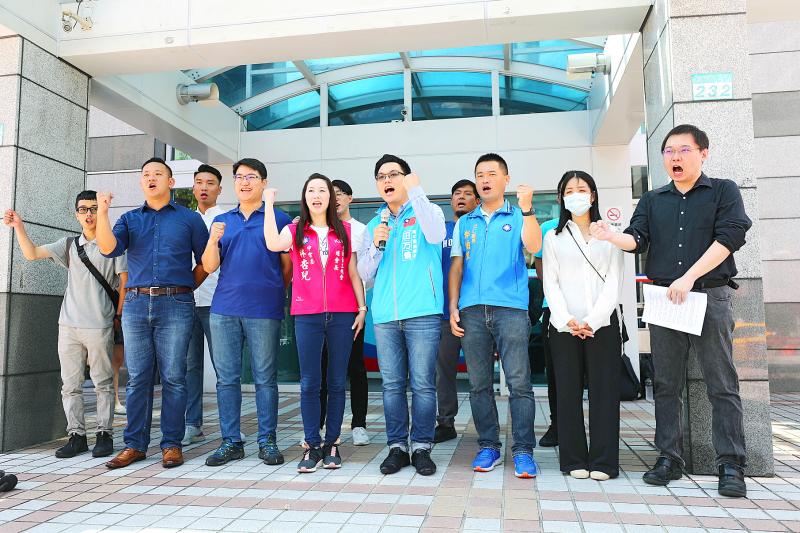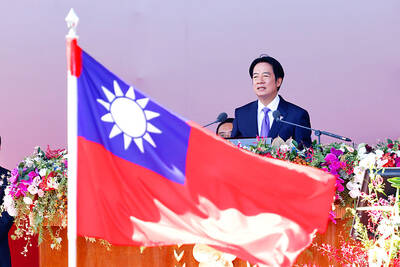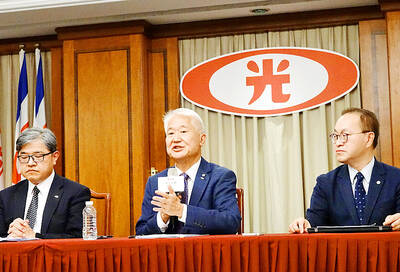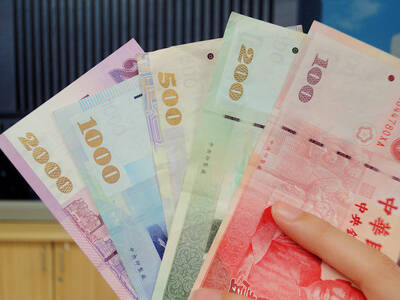Several members of the Chinese Nationalist Party (KMT) Reform Committee’s youth participation task force yesterday voiced their support for recommendations made by the committee’s cross-strait narrative task force and said they were not abandoning the “1992 consensus.”
The so-called “1992 consensus,” a term former Mainland Affairs Council chairman Su Chi (蘇起) in 2006 admitted making up in 2000, refers to a tacit understanding between the KMT and the Chinese Communist Party that both sides of the Taiwan Strait acknowledge there is “one China,” with each side having its own interpretation of what “China” means.
The KMT’s reform committee, of which KMT Chairman Johnny Chiang (江啟臣) is the general convener, is divided into four task forces focused on cross-strait narrative, organizational reform, youth participation and financial stability.

Photo: CNA
On Friday last week, the groups held their first joint meeting, during which the cross-strait narrative task force proposed “four pillars”: insisting on the sovereignty of the Republic of China (ROC); safeguarding freedom, democracy and human rights; prioritizing the safeguarding of Taiwan’s security; and creating a win-win situation and “shared prosperity.”
Speaking outside the KMT headquarters in Taipei yesterday, Taichung City Councilor Lo Ting-wei (羅廷瑋), a member of the youth participation task force, said that while some people who rely on history for a “sense of presence” might feel that their contributions are being erased, the committee was not erasing the “1992 consensus,” but rather hoped to add to the KMT’s narrative.
Lin Hsing-er (林杏兒), head of the KMT Department of National Youth Affairs and a member of the youth participation task force, said that young people are unfamiliar with the “1992 consensus.”
She compared the “consensus” to a point-and-shoot camera, saying it was no longer “in fashion.”
The KMT has never removed the “consensus” from its discourse, she said, but it should be repackaged into something that young people can understand.
Another member of the youth participation task force, Taipei City Councilor Hsu Chiao-hsin (徐巧芯), said that while some people question whether the KMT’s cross-strait narrative is moving closer to that of the Democratic Progressive Party (DPP), the reverse was true.
She said that the KMT should place its focus not on whether or not it wants the “1992 consensus,” but rather on the challenges the “consensus” faces and supervision of the ruling DPP.
Members of the youth participation task force also expressed their support for fellow member Kaohsiung City Councilor Jane Lee (李眉蓁), who on Tuesday was named the party’s candidate in the Kaohsiung mayoral by-election to be held on Aug. 15.
In related developments, former president Ma Ying-jeou (馬英九) yesterday on Facebook called on President Tsai Ing-wen (蔡英文) to acknowledge the “1992 consensus” to prevent the two sides of the Taiwan Strait from going to war.
Ma also called on Chinese authorities to stop menacing Taiwan with force.
Additional reporting by CNA

People can preregister to receive their NT$10,000 (US$325) cash distributed from the central government on Nov. 5 after President William Lai (賴清德) yesterday signed the Special Budget for Strengthening Economic, Social and National Security Resilience, the Executive Yuan told a news conference last night. The special budget, passed by the Legislative Yuan on Friday last week with a cash handout budget of NT$236 billion, was officially submitted to the Executive Yuan and the Presidential Office yesterday afternoon. People can register through the official Web site at https://10000.gov.tw to have the funds deposited into their bank accounts, withdraw the funds at automated teller

PEACE AND STABILITY: Maintaining the cross-strait ‘status quo’ has long been the government’s position, the Ministry of Foreign Affairs said Taiwan is committed to maintaining the cross-strait “status quo” and seeks no escalation of tensions, the Ministry of Foreign Affairs (MOFA) said yesterday, rebutting a Time magazine opinion piece that described President William Lai (賴清德) as a “reckless leader.” The article, titled “The US Must Beware of Taiwan’s Reckless Leader,” was written by Lyle Goldstein, director of the Asia Program at the Washington-based Defense Priorities think tank. Goldstein wrote that Taiwan is “the world’s most dangerous flashpoint” amid ongoing conflicts in the Middle East and Russia’s invasion of Ukraine. He said that the situation in the Taiwan Strait has become less stable

CONCESSION: A Shin Kong official said that the firm was ‘willing to contribute’ to the nation, as the move would enable Nvidia Crop to build its headquarters in Taiwan Shin Kong Life Insurance Co (新光人壽) yesterday said it would relinquish land-use rights, or known as surface rights, for two plots in Taipei’s Beitou District (北投), paving the way for Nvidia Corp to expand its office footprint in Taiwan. The insurer said it made the decision “in the interest of the nation’s greater good” and would not seek compensation from taxpayers for potential future losses, calling the move a gesture to resolve a months-long impasse among the insurer, the Taipei City Government and the US chip giant. “The decision was made on the condition that the Taipei City Government reimburses the related

FRESH LOOK: A committee would gather expert and public input on the themes and visual motifs that would appear on the notes, the central bank governor said The central bank has launched a comprehensive redesign of New Taiwan dollar banknotes to enhance anti-counterfeiting measures, improve accessibility and align the bills with global sustainability standards, Governor Yang Chin-long (楊金龍) told a meeting of the legislature’s Finance Committee yesterday. The overhaul would affect all five denominations — NT$100, NT$200, NT$500, NT$1,000 and NT$2,000 notes — but not coins, Yang said. It would be the first major update to the banknotes in 24 years, as the current series, introduced in 2001, has remained in circulation amid rapid advances in printing technology and security standards. “Updating the notes is essential to safeguard the integrity